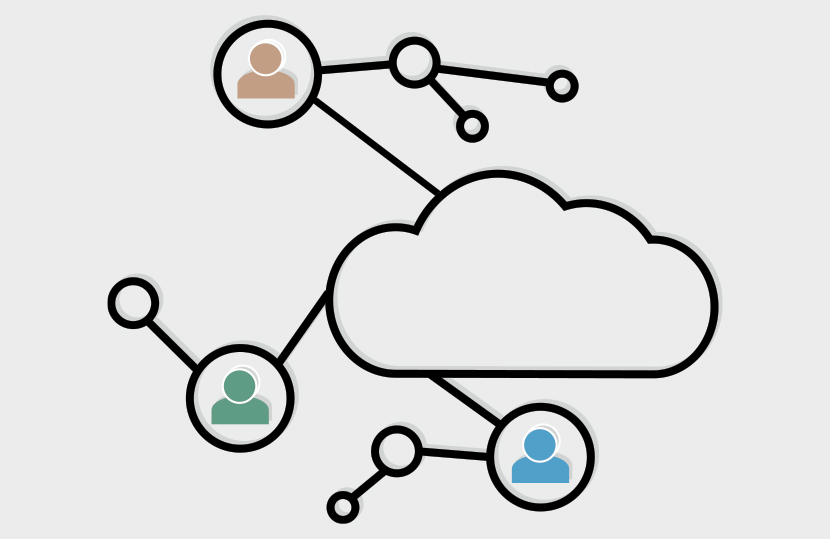This article appears in the Fall-Winter 2019 digital issue of DOCUMENT Strategy. Subscribe.

Perhaps the most common cloud content management application is simple file sharing and collaboration, which has been around for many years. However, these cloud systems are evolving to serve as the front-end of a large third-party database, such as Amazon Web Services (AWS), Google, or Oracle, spanning across many terabytes or even a petabyte of content.

Image by: Just_Super, ©2019 Getty Images
As more and more organizations look to move toward cloud content management, this particular technology segment is quickly evolving into a fragmented set of applications and tools. Today, cloud content management can be used in two main ways:
- To supplement your existing enterprise content management (ECM) system—basically acting as a collaborative front-end to the current system
- As a standalone solution that manages your documents and files
For example, take a global engineering company that has offices in 20 countries, operating 200 live projects, and managing a thousand more that are closed. It’s possible for an organization of this size to input more than 1,000 pieces of content into the system on a daily basis. At the same time, additional content is also added to the closed sites as well. Some of this activity supports updating databases for project status information, financial data, data analytics, and artificial intelligence (AI) initiatives.
Not only is there a high volume of content that is uploaded to the system, but there is also a constant stream of searches being performed and documents downloaded from all types of devices, including laptops, tablets, smartphones, and computer-to-computer updates and requests. In order to allow for this kind of volume, the cloud content management system requires a custom-built data capture front-end, tailored search capabilities for retrieval, and a customized data server to store the content.
Companies continue to grapple with a vast amount of unstructured content flowing into the organization on a daily basis. Such customization is necessary to allow users to add content quickly—without the need to manually tag metadata for each document—in a standardized process. This “standard” front-end automatically stores content into predetermined repositories (based on the geographical locations of the input, for example), which, in turn, assigns metadata to it and indexes the content as well.
Since content is automatically tagged with project name and number, document type, content type, country location, author, security and permission levels, etc., this metadata can easily be extracted from the document, leading to better search experiences for users across multiple projects and countries. In addition, using metadata with content type also assigns a retention period to each document and manages the retention cycle per the geographical location’s (i.e., country) regulations.
Global companies may also work with many outside consultants, contractors, legal companies, and others that participate in the input and search for content within the cloud content management system. As a result, security protocols must be well thought-out, be applied on a global basis, and must be continuously updated.
The type of system we’ve outlined here goes far beyond the typical cloud content management implementation, but it’s entirely possible to achieve. For example, the front-end may be a customized application, such as SharePoint or OpenText, while the back-end repository may be from Microsoft Azure, AWS, Hewlett Packard Enterprise (HPE), or IBM. In most cases, you will need to engage a system integrator to build and integrate the diverse components of the system and for any additional custom work as the system is put to use.
While organizations should consider detailed system requirements for this type of solution, the providers with the ability to build and maintain it may not be household names. In addition, finding the right system integrator can also help you to define the requirements you need. Some may look to IBM, HPE, or Oracle, but there are many system integrators that operate within a vertical industry, like energy, pharmaceuticals, manufacturing, insurance, retail, etc.
These large cloud-enabled content repositories are only possible with multiple cloud technologies that scale both in terms of content and users. At the same time, they must also provide the speed and uptime required for a globally dispersed solution. This type of system has the potential to store hundreds of millions of documents across the world for very long periods of time, some of which might be permanent.

Not only is there a high volume of content that is uploaded to the system, but there is also a constant stream of searches being performed and documents downloaded from all types of devices, including laptops, tablets, smartphones, and computer-to-computer updates and requests. In order to allow for this kind of volume, the cloud content management system requires a custom-built data capture front-end, tailored search capabilities for retrieval, and a customized data server to store the content.
Companies continue to grapple with a vast amount of unstructured content flowing into the organization on a daily basis. Such customization is necessary to allow users to add content quickly—without the need to manually tag metadata for each document—in a standardized process. This “standard” front-end automatically stores content into predetermined repositories (based on the geographical locations of the input, for example), which, in turn, assigns metadata to it and indexes the content as well.
Since content is automatically tagged with project name and number, document type, content type, country location, author, security and permission levels, etc., this metadata can easily be extracted from the document, leading to better search experiences for users across multiple projects and countries. In addition, using metadata with content type also assigns a retention period to each document and manages the retention cycle per the geographical location’s (i.e., country) regulations.
Global companies may also work with many outside consultants, contractors, legal companies, and others that participate in the input and search for content within the cloud content management system. As a result, security protocols must be well thought-out, be applied on a global basis, and must be continuously updated.
The type of system we’ve outlined here goes far beyond the typical cloud content management implementation, but it’s entirely possible to achieve. For example, the front-end may be a customized application, such as SharePoint or OpenText, while the back-end repository may be from Microsoft Azure, AWS, Hewlett Packard Enterprise (HPE), or IBM. In most cases, you will need to engage a system integrator to build and integrate the diverse components of the system and for any additional custom work as the system is put to use.
While organizations should consider detailed system requirements for this type of solution, the providers with the ability to build and maintain it may not be household names. In addition, finding the right system integrator can also help you to define the requirements you need. Some may look to IBM, HPE, or Oracle, but there are many system integrators that operate within a vertical industry, like energy, pharmaceuticals, manufacturing, insurance, retail, etc.
These large cloud-enabled content repositories are only possible with multiple cloud technologies that scale both in terms of content and users. At the same time, they must also provide the speed and uptime required for a globally dispersed solution. This type of system has the potential to store hundreds of millions of documents across the world for very long periods of time, some of which might be permanent.
Bud Porter-Roth has over 20 years of experience as an enterprise content management (ECM) consultant, with a focus on cloud collaboration, electronic document management, records management, and paper document projects. He is also the author of Request for Proposal: A Guide for Effective RFP Development. Follow him on Twitter @BudPR or contact him at info@erms.com.
3 Factors to Consider Before You Move to the Cloud

1. Type of Cloud Service: One of the critical factors to consider before moving your content system to the cloud is the type of service that will be required. Ask yourself the following questions: Do you want to be on a multi-tenant environment (like Box) or a fully managed service (like Viewpointe)? Have you considered a hybrid approach, where new content goes into Amazon Web Services (AWS) while your historical content remains on-premises?
2. Integration with Content-Generating and Content-Consuming Applications: Organizations should also thoroughly understand the need for integration with content-generating applications and content-consuming applications. A simple search user interface is an example of a consuming application. Most of our clients will have 15 to 30 different consuming applications, so the cost of re-wiring these to access content in the cloud can be considerable. The same can be true with content-generating applications (like a correspondence system).
3. Metadata and Information Architecture: A major change, like the adoption of a new content system (cloud or otherwise), creates the opportunity to re-think how content is indexed. Creating an effective information architecture is a worthwhile endeavor, given the impact on user experience and the potential productivity gains.
James Watson is the CEO and Founder of Doculabs, a consultancy firm specializing in content-based applications and enterprise content management (ECM) technologies to help improve the management of business content. Visit www.doculabs.com for more information or email him at jwatson@doculabs.com.









